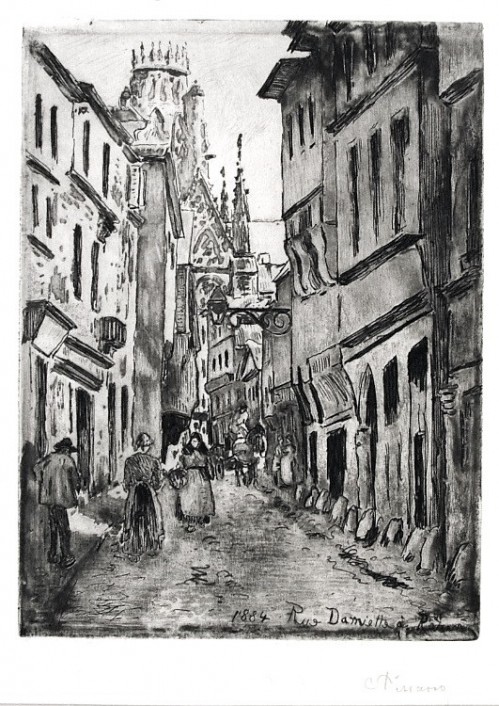Rue Damiette, a Rouen
 Camille Pissarro (1830-1903), Rue Damiette, a Rouen; etching, drypoint and aquatint, 1884, signed bottom right [also dated and titled in the plate lower right]. Reference: Delteil 52, second state (of 2). Delteil notes that 9 proofs were pulled before steelfacing, and another 8 or 9 after (among the lifetime impressions); the earlier group was numbered according to Delteil, and so this impression may have been in the second group. In very good condition with full margins, slightest rubbing in margin to left of signature (visible only in a raking light, not near image); thin areas in margins verso inherent in handmade paper. On a hand made laid paper, without watermark, 7 7/8 x 5 7/8, the sheet 13 3/4 x 10 1/4 inches, archival mounting with silk window mat.
Camille Pissarro (1830-1903), Rue Damiette, a Rouen; etching, drypoint and aquatint, 1884, signed bottom right [also dated and titled in the plate lower right]. Reference: Delteil 52, second state (of 2). Delteil notes that 9 proofs were pulled before steelfacing, and another 8 or 9 after (among the lifetime impressions); the earlier group was numbered according to Delteil, and so this impression may have been in the second group. In very good condition with full margins, slightest rubbing in margin to left of signature (visible only in a raking light, not near image); thin areas in margins verso inherent in handmade paper. On a hand made laid paper, without watermark, 7 7/8 x 5 7/8, the sheet 13 3/4 x 10 1/4 inches, archival mounting with silk window mat.
A fine atmospheric impression of one of the most successful of the Rouen cityscapes, in which Pissarro employs the “manier grise” aquatint technique (discussed below) effectively. A great rarity, we know of only one lifetime signed impression to come on the market in the past 15 years.
Pissarro was perhaps the most active printmaker of the Impressionists; printmaking was an essential component of his career, and he was deeply involved in the process of creating and printing his prints. By mid-career Pissarro had made many etchings, using fairly conventional techniques (although of course aesthetically his work was hardly conventional), but it was Degas who introduced Pissarro to a range of unusual ways of working with the etching plate – especially the use of aquatint. At this point Pissarro was about 50. He worked closely with Degas for several years; they both enjoyed working carefully and painstakingly to refine an image or composition, and often incorporating accidents or unanticipated results in the print.
Rue Damiette a Rouen was made about 5 years after Pissarro first began working on the refinements of printmaking with Degas. Among other innovations, they developed a variant of the aquatint technique called “maniere grise”, in which they scraped the plate with an emery point; that technique appears to have been used extensively in this print. As noted, Pissarro and Degas both loved to re-work their plates through a number of states, carefully giving the plates different shadings and nuances, e.g., there are at least two layers of aquatint in this impression, as well as some carefully wiped plate tone. Of course this meant that the plates could withstand only very limited printings, and today these prints are of the utmost rarity.
Pissarro did not like professional printing of his etchings, and so he printed his plates himself (also Degas apparently printed many Pissarro proofs). The concept was not to produce a large edition of prints similar in appearance (only about 5 of Pissarro’s prints were in fact editioned during his lifetime); printmaking for Pissarro was a way of experimenting, achieving variations in light, mood, sensibility, with each proof. He did not intend to earn much money through printmaking (and he never did). In 1883 Pissarro was painting at Rouen, and returned to Paris with a number of sketches and full of recollections, which he used in developing the Rouen prints, which were probably completed in early 1884; Pissarro did not yet have a printing press of his own, so he used printing facilities in Paris. These are among his most engaging prints, and Rue Damiette a Rouen is among the most successful of this group.